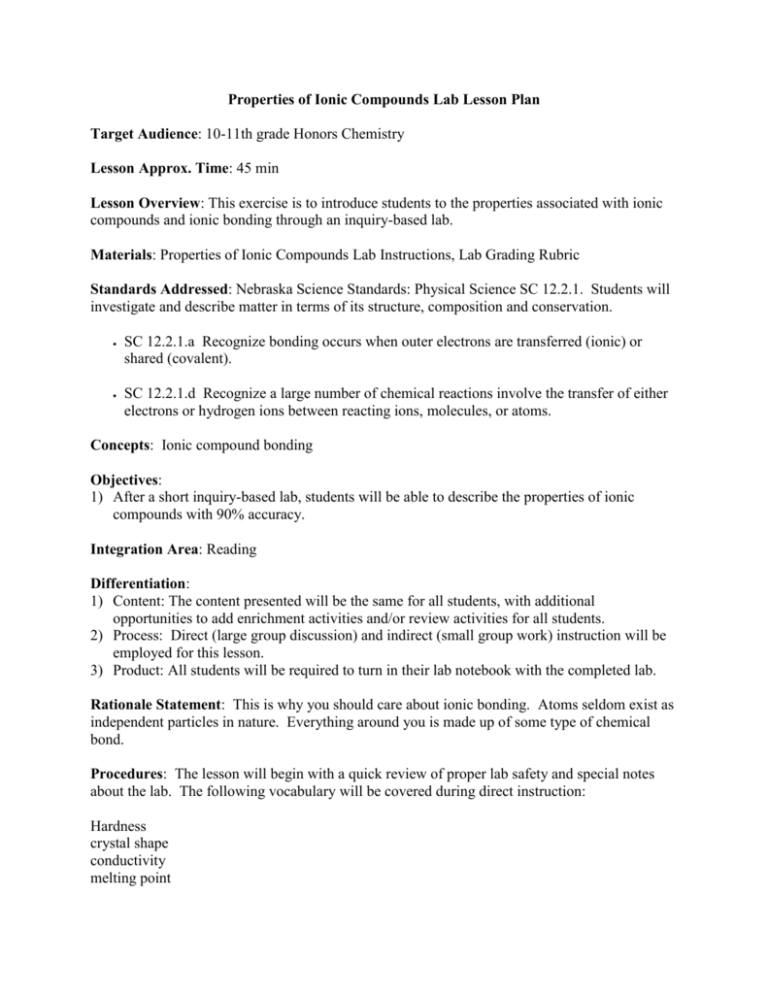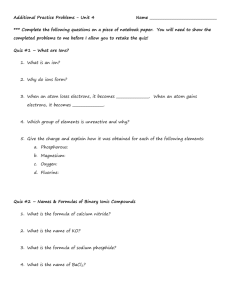Properties of Ionic Compounds Lab Lesson
advertisement

Properties of Ionic Compounds Lab Lesson Plan Target Audience: 10-11th grade Honors Chemistry Lesson Approx. Time: 45 min Lesson Overview: This exercise is to introduce students to the properties associated with ionic compounds and ionic bonding through an inquiry-based lab. Materials: Properties of Ionic Compounds Lab Instructions, Lab Grading Rubric Standards Addressed: Nebraska Science Standards: Physical Science SC 12.2.1. Students will investigate and describe matter in terms of its structure, composition and conservation. SC 12.2.1.a Recognize bonding occurs when outer electrons are transferred (ionic) or shared (covalent). SC 12.2.1.d Recognize a large number of chemical reactions involve the transfer of either electrons or hydrogen ions between reacting ions, molecules, or atoms. Concepts: Ionic compound bonding Objectives: 1) After a short inquiry-based lab, students will be able to describe the properties of ionic compounds with 90% accuracy. Integration Area: Reading Differentiation: 1) Content: The content presented will be the same for all students, with additional opportunities to add enrichment activities and/or review activities for all students. 2) Process: Direct (large group discussion) and indirect (small group work) instruction will be employed for this lesson. 3) Product: All students will be required to turn in their lab notebook with the completed lab. Rationale Statement: This is why you should care about ionic bonding. Atoms seldom exist as independent particles in nature. Everything around you is made up of some type of chemical bond. Procedures: The lesson will begin with a quick review of proper lab safety and special notes about the lab. The following vocabulary will be covered during direct instruction: Hardness crystal shape conductivity melting point Illustrated Lecture: 1) Students should come prepared with lab write-up started. 2) Quick demonstration about how to set up the Bunsen burner. 3) Students will work in small learning groups on the Properties of Ionic Compounds Lab. I will walk around the room and model proper lab techniques. 4) Students will then finish their lab reports with a proper conclusion and the lab will be due two days following the lab. Modeling: I will walk around the room wearing goggles and an apron. I will ask the students questions about their set-ups. Guided Practice: I will assist students on properly setting up their Bunsen burner for the lab. Checking for Understanding: I will ask students questions as they working in the lab. Independent Practice: Students will work on the conclusion and analysis portion of the lab on their own time. Assessment: 1) Students will be assessed on their ability students will be able to describe the properties of ionic compounds. Closure: Students will be engaged in discussion as they work through the lab. Sources: Holt/McDougal (2012) Chemistry, Orlando, FL. Houghton Mifflin Harcourt Publishing Company Lab Adapted from: Bronwyn Hogan, October 25, 2004, http://ioniccompounds.webs.com/properties_of_ionic_compounds_lab.doc







